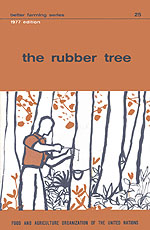
| better farming series | 25 |
| FAO Economic and Social Development Series | No. 3/25 |
 | the rubber tree |
Published by arrangement with the
Institut africain pour le développement économique et social
B.P. 8008, Abidjan, Côte d'Ivoire
First printing 1977
ISBN 92-5-100156-1
BETTER FARMING SERIES
Twenty-six titles have been published in this series, designed as handbooks for a two-year intermediate level agricultural education and training course. They may be purchased as a set or as individual documents.
FIRST YEAR
SECOND YEAR
This manual is a translation and adaptation of “L'hévéa,” published by the Agri-Service-Afrique of the Institut africain pour le développement économique et social (lNADES),and forms part of a series of 26 booklets. Grateful acknowledgement is made to the publishers for making available this text, which it is hoped will find widespread use at the intermediate level of agricultural education and training in English-speaking countries.
The original texts were prepared for an African environment and this is naturally reflected in the English version. However, it is expected that many of the manuals of the series — a list of which will be found on the inside front cover — will also be of value for training in many other parts of the world. Adaptations can be made to the text where necessary owing to different climatic and ecological conditions.
Applications for permission to issue this manual in other languages are welcomed. Such applications should be addressed to: Director, Publications Division, Food and Agriculture Organization of the United Nations, Via delle Terme di Caracalla, 00100 Rome, Italy.
The author of this English version is Mr. A.J. Henderson, former Chief of the FAO Editorial Branch.
FOOD AND AGRICULTURE ORGANIZATION OF THE UNITED NATIONS
Rome 1977
© French edition, Institut africain pour
le développement économique et social (INADES) 1969
© English edition, FAO
Hyperlinks to non-FAO Internet sites do not imply any official endorsement of or responsibility for the opinions, ideas, data or products presented at these locations, or guarantee the validity of the information provided. The sole purpose of links to non-FAO sites is to indicate further information available on related topics.
This electronic document has been scanned using optical character recognition (OCR) software. FAO declines all responsibility for any discrepancies that may exist between the present document and its original printed version.
• Where rubber trees are grown
Germinating seeds in the germinator
Putting the germinated seeds in the nursery
• Preparing the ground and making the plantation
Putting the young plants in the plantation
• Looking after the plantation
Protection against disease and insects
• Tapping